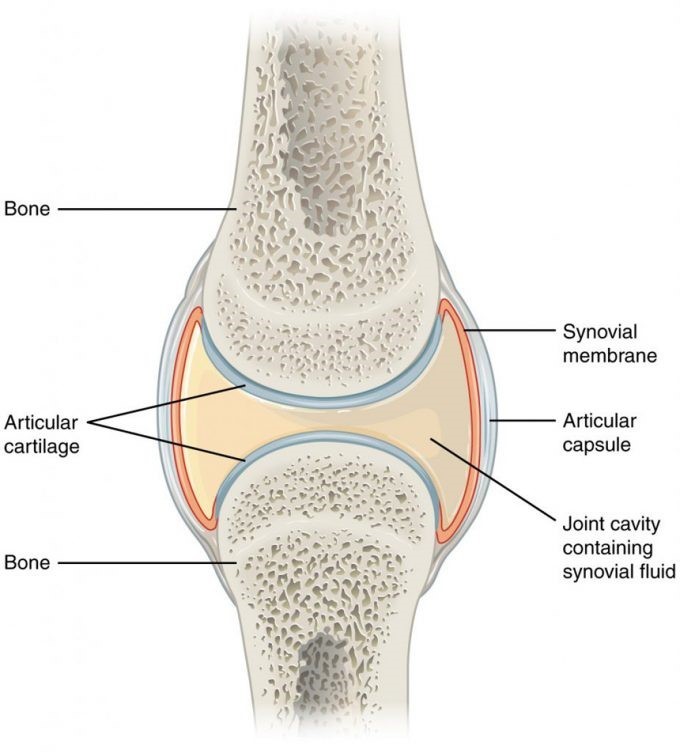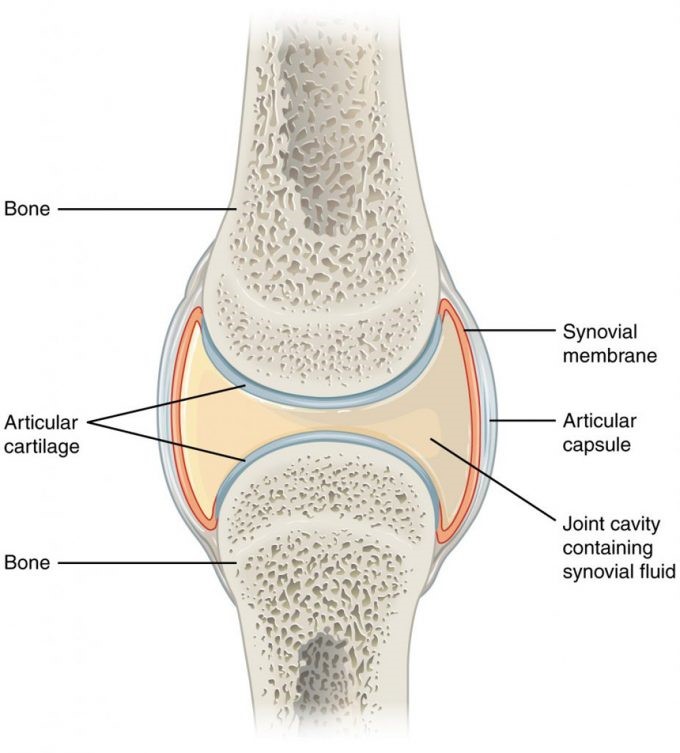Joint health is really important not only for our horses’ performance but also for their welfare and quality of life. We often consider joint health more closely in older horses and add supplements such as glucosamine to our veterans’ diets. But should we be supporting joint health throughout their lives?
The first question is, what are joints? Joints are areas where 2 or more bones meet. Most allow movement, but a few do not. There are 3 main types of joints; synovial joints, fibrous joints and cartilaginous joints.
Synovial joints are the most common and these allow the most movement. Synovial joints come in all different shapes and sizes, from the ball and socket of the hip joint to the hinge joint in the stifle. Synovial joints consist of:
- The ends of 2 or more bones covered in a layer of articular cartilage
- An outer fibrous capsule surrounding the joint
- A synovial membrane lining the inner surface of the capsule
- A cavity between the bones filled with synovial fluid

Fibrous Joints are joined by dense connective tissue and they do not allow any movement. An example of Fibrous Joints are those between the bones making up the skull.
The third type of joints are cartilaginous joints, in which 2 bones are joined by cartilage. These allow more movement than fibrous joints but less that synovial joints. Cartilaginous joints can be found between the vertebrae which make up the spine.
As Synovial Joints are responsible for almost all movement, it is generally these we consider when looking at joint health from a nutritional perspective.
The most common joint problem in horses is osteoarthritis. In fact, this is the biggest cause of lameness in horses in the United Kingdom (1). Often we associate osteoarthritis with older horses, but actually it is a progressive, degenerative disease that can affect any horse at any age. Trauma, infection or overloading of joints can lead to inflammation in the joint and start the cascade of events leading to the breakdown of cartilage associated with osteoarthritis.
Joint health in youngstock is critical; incorrect management, forced exercise or inadequate nutrition can increase the risk of developmental orthopaedic diseases. Physitis, Osteochondritis Dissecans (OCD) or Angular Limb Deformities are all examples, which can then increase the risk of arthritis or other joint conditions later in life.
As our horses get older and we begin to bring them into work we will be increasing the strain on their joints. From eventers jumping, racehorses galloping, dressage horses performing passage, all the way through to trail horses trekking over many miles we expect a lot from our horse's joints. So irrespective of the age or workload of our horses, providing extra support for the joints could be beneficial. But how can we do this?
Some nutritional joint supplements provide potential building blocks for the molecules which are structurally important for the cartilage in joints. Many commercially available joint supplements contain Glucosamine or Chondroitin Sulphate. Research points to 3 possible mechanisms by which these molecules can support joint health:
- Inhibiting enzymes and regulatory molecules involved in the breakdown of cartilage (2)
- Stimulating build-up of key components of the extracellular matrix which is responsible for the structural integrity of cartilage (3)
- Supply building blocks for the synthesis of glycosaminoglycans which are important molecules in the structure of cartilage (3)
Hyaluronic Acid is a key component of the synovial fluid of joints. Normally Hyaluronic Acid is given by injection into the joint, and there is little evidence of beneficial effects of oral supplementation (4,5).
Methylsulfonylmethane, or MSM, is a naturally occurring sulphur containing compound. Studies suggest that MSM may have anti-inflammatory and analgesic properties. Human studies show improvement in the symptoms associated with degenerative arthritis when given MSM (6,7,8), but there hasn’t been significant research in equines.
Nutritionists also believe that omega 3 and 6 fatty acids may be beneficial for supporting the joints. Research shows that supplementing with omega 3 fatty acids can reduce joint inflammation in yearlings and in horses with arthritis (9), and possibly increase stride length (10). Marine algae and olive extract provide very good sources of omega 3 fatty acids.
Some horse owners prefer “natural” herbal joint supplements for their horses. For hundreds of years Turmeric has been used in human and equine medicine and many people believe it to have anti-inflammatory and anti-arthritic properties. The active ingredient, Curcumin, is only present in small quantities (2%) and there has not been enough research to suggest whether Tumeric could be beneficial for supporting joint health in horses (11).
Although supplements can support the health of the joints there are many other factors which can have an influence. We’ve put together some top tips to keep your horse’s joints in the best condition for longer:
- Ensure your horse is receiving a well-balanced diet, providing a diet that meets all vitamin and mineral requirements on a daily basis
- Keep your horse at an ideal weight – carrying extra weight will increase stress on the joints (ideal body condition score is a 3 out of 5)
- Ensure your horse’s hooves are regularly trimmed and shoed where required – imbalances will increase strain on the joints
- Look out for early signs of joint problems such as heat, lameness or swelling
- Limit work on hard surfaces
- Build up workload steadily, particularly after a period of rest or injury
If you require any assistance in formulating the right diet for your horse, then please do not hesitate to contact our Nutritional Helpline on 01832737300 for friendly nutritional advice.

References:
- 1. Clegg, P. and Booth, T., 2000. Drugs used to treat osteoarthritis in the horse. In Practice, 22(10), pp.594-603.
- 2. Sandy, J.D., Gamett, D., Thompson, V. and Verscharen, C., 1998. Chondrocyte-mediated catabolism of aggrecan: aggrecanase-dependent cleavage induced by interleukin-1 or retinoic acid can be inhibited by glucosamine. Biochemical Journal, 335(1), pp.59-66.
- 3. Dechant, J.E. and Baxter, G.M., 2007. Glucosamine and chondroitin sulphate as structure modifying agents in horses. Equine Veterinary Education, 19(2), pp.90-96.
- 4. Necas, J.B.L.B.P., Bartosikova, L., Brauner, P. and Kolar, J., 2008. Hyaluronic acid (hyaluronan): a review. Veterinarni medicina, 53(8), pp.397-411.
- 5. Schultz, R.H., Wollen, T.H., Greene, N.D., Brown, K.K. and Mozier, J.O., Mobay Corp, 1989. Remote administration of hyaluronic acid to mammals. U.S. Patent 4,808,576.
- 6. Ezaki, J., Hashimoto, M., Hosokawa, Y. and Ishimi, Y., 2013. Assessment of safety and efficacy of methylsulfonylmethane on bone and knee joints in osteoarthritis animal model. Journal of bone and mineral metabolism, 31(1), pp.16-25.
- 7. Butawan, M., Benjamin, R. and Bloomer, R., 2017. Methylsulfonylmethane: applications and safety of a novel dietary supplement. Nutrients, 9(3), p.290.
- 8. Lawrence, R.M., 1998. Methylsulfonylmethane (MSM): a double-blind study of its use in degenerative arthritis. Int J of Anti-Aging Med, 1(1), p.50.
- 9. Woodward, A.D., Nielsen, B.D., O'Connor, C.I., Skelly, C.D., Webel, S.K. and Orth, M.W., 2007. Supplementation of dietary long-chain polyunsaturated omega-3 fatty acids high in docosahexaenoic acid (DHA) increases plasma DHA concentration and may increase trot stride lengths in horses. Equine and Comparative Exercise Physiology, 4(2), pp.71-78.
- 10. Ross-Jones, T.N., McIlwraith, C.W., Kisiday, J.D. Influence of an n-3 long-chain polyunsaturated fatty acid-enriched diet on experimentally induced synovitis in horses. Journal of Animal Physiology and Animal Nutrition. 100(3): 565-577.
- 11. Marlin, D., Nielsen, B., Robison, C. and Williams, C., 2017. Owner-reported experiences of feeding turmeric to horses. Journal of Equine Veterinary Science, 100(52), p.88.



